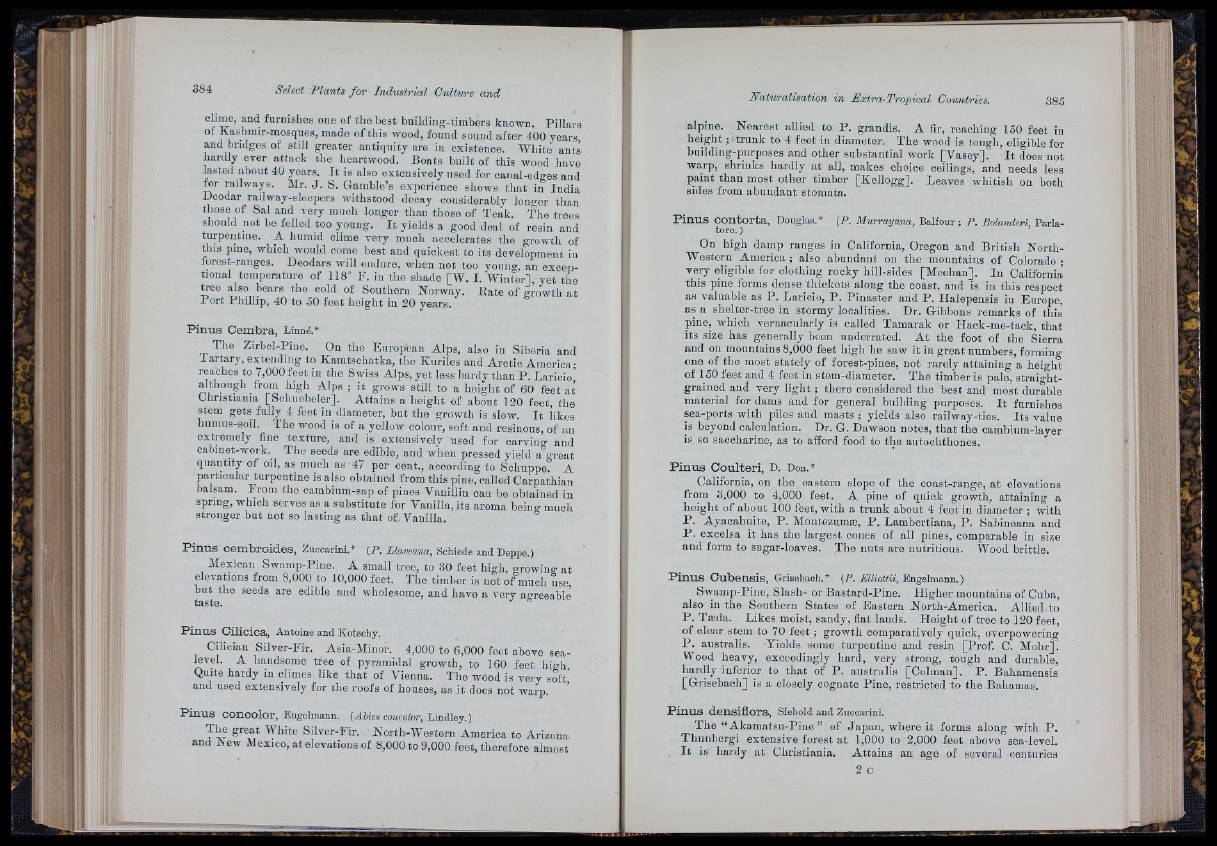
Select Plants fo r Industrial Culture and
clime, and furnishes one of the best building-timbers known. Pillars
of Kashmir-mosques, made of this wood, found sound after 400 years
and bridges of still greater antiquity are in existence. White ants-
hardly ever attack the lieartwood. Boats built of this wood have
lasted about 40 years. I t is also extensively used for canal-edges and
for railways. Mr. J . S. Gamble’s experience shows th a t in India
Deodar railway-sleepers withstood decay considerably longer tlian
those of Sal and very much longer than those of Teak. The trees
should not be felled too young. I t yields a good deal of resin and
turpeitime. A humid clime very much accelerates the growth of
this pine, which would come best and quickest to its development in
forest-ranges. Deodars will eiulnre, when not too young, an exceptional
temperature of 118° F. in the shade [W. I. Winter], yet the
tree also bears the cold of Southern Norway. Rate of growth a t
Po rt Phillip, 40 to 50 feet height in 20 years.
Pinus Cembra, Linné.*
The Zirbel-Pme. On the European Alps, also in Siberia and
la rta ry , extending to Kamtscliatka, the Kuriles and Arctic America-
reaches to 7,000 feet in the Swiss Alps, yet less hardy than P . Larieio’
although from high Alps ; it grows still to a height of 60 feet at
Christiania [Schuebeler]. Attains a height of abont 120 feet, the
stem gets fully 4 feet in diameter, hut the growth is slow. I t likes
humus-soil. The wood is of a yellow colour, soft and resinous, of an
extremely fine texture, and is extensively used for carving and
cabinet-work. The seeds are edible, and when pressed yield a great
quantity of oil, as much as 47 per cent., according to Schuppe A
particular turpentine is also obtained from this pine, called Carpathian
balsam. From the cambium-sap of pines Vanillin can be obtained in
spring, which serves as a substitute for Vanilla, its aroma being much
stronger but not so lasting as th a t of Vanilla.
Pinus cembroides, Zuccarini.* {P. Llaveana, Soliiede and Deppe.)
Mexican Swamp-Pine. A small tree, to 30 feet high, growing a t
elevations from 8,000 to 10,000 feet. The timber is not of much use,
bnt the seeds are edible aud wholesome, and have a verv aoreeable
taste. ^ °
Pinus OiUcica, Antoine and Kotschy.
Cilician Silver-Eir. Asia-Minor. 4,000 to 6,000 feet above sea-
level. A handsome tree of pyramidal growth, to 160 feet high
Quite hardy iu climes like th a t of Vienna. The wood is very soft’
aud used extensively for the roofs of houses, as it does not warp. ’
Pinus concolor, Engelmann. {Ahies concolor, Lindley.)
The great White Silver-Fir. North-Western America to Arizona
and New Mexico, at elevations of 8,000 to 9,000 feet, therefore almost
Naturalisation in Extra-Tropical Countries. 385
alpine. Nearest allied to P. grandis. A fir, reaching 150 feet in
h e ig h t; trunk to 4 feet iu diameter. The wood is tough, eligible for
building-purposes and other substantial work [Vasey]. I t does not
warp, shrinks hardly a t all, makes choice ceilings, and needs less
paint than most other timber [Kellogg], Leaves whitish on both
sides from abundant stomata.
Pinus contorta, Douglas.* {P. Murrayana, Balfour: P. Bolanderi. Parlatore.
)
On high damp ranges in California, Oregon and British North-
Western America ; also abundant on the mountains of Colorado ;
very eligible for clothing rooky hill-sides [Meehan]. In California’
this pine forms dense thickets along the coast, and is in this respect
as valuable as P . Larieio, P . Pinaster and P. Halepensis iu Europe,
as a shelter-tree in stormy localities. Dr. Gibbons remarks of this
pine, which vernacularly is called Tamarak or Hack-me-tack, that
its size has generally been underrated. A t the foot of the Sierra
aud on mountains 8,000 feet high he saw it in great numbers, forming
one of the most stately of forest-pines, not rarely attaining a height
of 150 feet and 4 feet in stem-diameter. The timber is pale, straight-
grained and very light ; there considered the best and most durable
material for dams and for general building purposes. I t furnishes
sea-ports with piles and masts ; yields also railway-ties. Its value
is beyond calculation. Dr. G. Dawson notes, th a t the cambium-layer
is so saccharine, as to afford food to the autochthones.
Pinus Coulteri, D. Don.*
California, on the eastern slope of the ooast-range, at elevations
from 3,000 to 4,000 feet. A pine of quick growth, attaining a
height of about 100 feet, with a trunk about 4 feet in diameter ; with
P . Ayacahuite, P. Montezumie, P . Lambertiana, P. Sabiueana and
P . excelsa it has the largest cones of all pines, comparable in size
and form to sugar-loaves. The nuts are nutritious. Wood brittle.
Pinus Cubensis, Grisebach.* {P. ElUottii, Engelmann.)
Swamp-Pine, Slash- or Bastard-Pine. Higher mountains of Cuba,
also in the Southern States of Eastern North-America. Allied to
P . Tieda. Likes moist, sandy, flat lands. Height of tree to 120 feet,
of clear stem to 70 f e e t; growth comparatively quick, overpowering
P . australis. Yields some turpentine and resin [Prof. C. Mohr].
Wood heavy, exceedingly hard, very strong, tough and durable,
hardly inferior to that of P . australis [Colman]. P . Bahamensis
[Grisebach] is a closely cognate Pine, restricted to the Bahamas.
Pinus densiflora, Siebold and Zucoarini.
The “ Akamatsu-Pine ” of Japan, where it forms along with P .
Thunbergi extensive forest at 1,000 to 2,000 feet above sea-level.
I t is hardy a t Christiania. Attains an age of several centuries
lU ‘ii